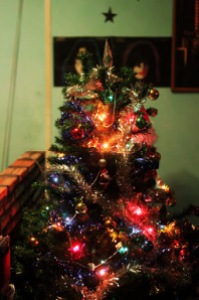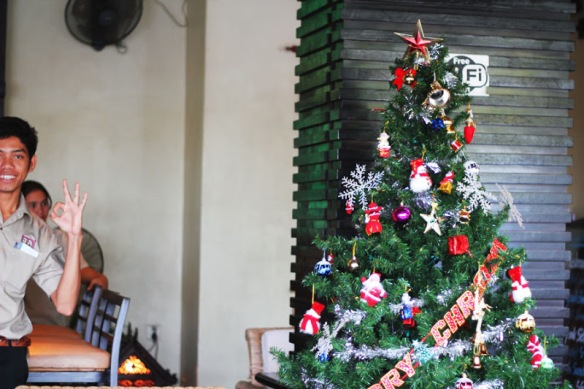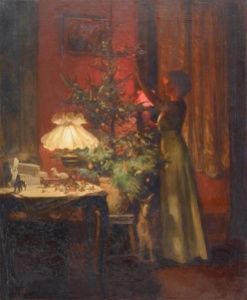I’ve been living in countries that are not America, where they have Holiday Traditions I remember reading about in picture books in fifth grade. In the places I have been recently, holidays involve things like throwing rice to your dead extended families, Easter processions that visit eight different chapels, and a Balinese day of silence where Australian tourists are occasionally pounded for un-reverently drinking Fosters.
All this seemed awfully odd until I came back to the US for graduate school and, for the first time in three years, went to purchase a Christmas tree with my family.
I got to the lot where I’ve been going since 2001 one evening in December right before the rush but after the enthusiastic day-after-Thanksgiving crowd. The lot that we go to is staffed entirely by solid-looking Oregonian man in plaid shirts and their teenage sons.We had put on entirely too warm clothes for the 50 degree weather, to get ourselves in the right sort of mood. We began the inspection.
I examined the trees and I imagined explaining this Christmas tree business to a hypothetical Cambodian person, preferably someone who had not been over-burdened with elementary school picture books about strange lands that are far away.
“Well, you see, these strange men drive here from far away with a large truck full of trees. I mean, live trees, they’re not cut into logs or anything. They’re not for ornamental tables, or export. Really.”

The Cambodian person would take a sip from their Angkor beer and raise their eyebrows at me, delicately.
The trees at our California Christmas tree lot are stood up in a grid of straight lines, lit by twinkling white lights. We are shopping for a forest plant for our home, and this is considered perfectly normal.
“We’re having a great deal on silver tips,” the Oregonian lumberjack notes somewhere behind us as we wander, assuming we are well-versed in tree jargon. Americans know their ornamental trees, and the varieties that they come in, it is assumed. We are all life-long experts on decorative tree selection. We all remember that scene from “A Christmas Story.”
“Well, then the whole family drives out to the tree lot and….no, it’s not a mall, it’s just sort of a yard. Usually behind a taco place. Yes, it’s cold. And then the family walks around and examines all the trees with great interest,” I’d say.
As a small child, I had taken extreme interest in selecting a tree, for reasons that are gauzy and obscure to me now. Mostly I was concerned with obtaining the biggest possible tree that would fit in our house, because it would be cool and also because, in the finest Calvin and Hobbes tradition, it would be then possible to fit that many more presents underneath it.
Privileged American children tend to assume a direct correlation between the length of a tree trunk and the quantity of Christmas presents they will obtain. In a direct commentary on our society, they are generally never proven wrong.
“I like him,” my dad says, pointing to a fluffy tree that is exactly identical to all the other trees to me. He is very big on gendering inanimate objects, although I’m fairly sure only the trees know for sure.“It’s all symmetrical, and it’s the right height.”
My formerly finely tuned ability to determine which tree is superior left me years ago, when I realized that the correlation between tree trunks and presents was negligible, when I reached the age when all the presents I ever seemed to want arrived in an envelope and were in the form of cold, hard cash.
“It’s a nice tree,” I say, gazing upon the piney object. “It does all the…tree stuff.” The somewhat chilly California air is scented with pine needles, and the faint smell of cooking tacos from next door. I am standing there and trying to focus on assessing the tree, but I am internally still explaining this entire affair to the metaphorical Cambodian In My Head.
“It actually isn’t really that simple a process, selecting this tree. The whole family generally argues over it. It’s especially concerning for children. I mean, you want to get the best one. They cost $99 after all. Yes, $99. Yes, that’d likely buy a lot of Christmas presents but that isn’t really something people contemplate.”
We wander down the aisles to the other side of the lot, to inspect the Silver Tips. I think they look rather lovely, sort of like a pine tree I recall seeing on a mountain in Vietnam, another place where they don’t have Christmas tree lots. I imagine buying the tree and hanging it with tasteful regional ornaments that I’ve accumulated over the years from many foreign lands that frown upon murdering and then decorating trees.
“I don’t really like it,” my dad says. “They don’t really do that twinkling thing well.”
“It’s an artsy kind of tree,” I say, in a half-hearted sort of argument.
My mother agrees. “It’s a very contemporary sort of tree.”
Dad humphs. Nostalgia wins out. There will be no contemporary trees this year. Preferably none of the years, unless I somehow find myself in a contemporary white home in the shape of a shoebox on the hills of Los Angeles, in which case I will do whatever I want. The mission continues.
“No, you don’t keep it for next year, that’s considered pretty gauche,” I explain to my my Metaphorical Cambodian. “You have to throw it out, at least by New Years Day. The homeowners association might call. The homeowners association? It’s well..we should stay on topic.”
Throwing out the tree always caused me considerable emotional pain post-Christmas, at least when I was a small child. The tree was symbolic of a day of the year when I got a lot of presents and was allowed to stay home from school for untold weeks. The tree was a magical reminder of the Happiest Time of The Year for everyone ever subjected to elementary school, and as long as the talisman lasted, so too did the holiday. The object was to avoid Letting Go of Christmas. When the Boy Scouts came to haul it out, your freedom went with it.
Furthermore — rather like my father and the genders of trees— I was prone to the wildest kind of anthropomorphizing, ascribing unique personalities to objects from staplers to CD drives to my computer. I felt sorry for them, secretly, wondered about their hopes and dreams and aspirations.
The tree, in line with the pagan notions that likely gave the tradition birth in early Western history, had taken on significant pagan meaning to my seven year old psyche, which was at the time willing to be convinced that a black dish towel was a potentially living, feeling, life companion. I was raised godlessly, but I definitely worshipped the Christmas tree.
I suspect many people under the age of ten would happily join that Christmas Tree cult, that pagan sector that would occasionally make sacrifices of cookies and water and particularly auspicious ornaments to the Vegetable God.
Sometimes I saved the pine tree needles after the tree had been discarded, and would sniff them until they lost their scent, out of a combination of both sentimentality and the vague feeling that they were some sort of magical, mildly consumerist talisman of good elementary-school fortune. The tree’s remnants, to me, were something like the bejeweled relics of Saints viewable at the Vatican.
“Well, once you get the tree into the house, you decorate it. You know, sort of like a Chinese New Years tree, but without the firecrackers. Yes, it’s not nearly as fun. It’s more…glass balls, and dead-eyed teddy bear ornaments that family friends who don’t know you too well give you but you feel obliged to keep, and also random stale candy that everyone regrets eating immediately after they pick it off the tree.”
We come back to a tree again, the first one we saw. Dad regards it with serious, intellectual interest. “Which one?” he asks. “You should break the tie.”
“It’s a nice tree!” I say, over enthusiastically. “We need this one.”
“But it’s got a gap in it.”
“That one in the back then!” I say, mildly tensely. It’s cold outside and I am weak. The tree is a tree, the presents will fit.
We get the tree inside the house, after it has sat outside overnight and accumulated an unhealthy quantity of water. We press on, anyway — as I make myself scarce, eager to avoid the annual You’re Holding Your Hands Wrong eternal parental debate. The tree is set up, and a bonnet is placed around it.
The ornament boxes come out, smelling slightly sweet as they always have — the nostalgia of elderly plush plastic reindeer and Korean ornaments my mom accumulated from her childhood in Seoul, the glass ornaments that dwindle in population every year as we break them.
There’s the wicker Christmas scorpion I acquired somewhere and always move to the back. The tree is living scrapbook, an annual antiques show. It comes together, tacky and rainbow-lit and impressive, and I am proud of it. I hope our annual visitors will look at it closely, and wonder.
“We put the ornaments on the tree, and then we put lights on it. Yes, electrical lights. It adds to the energy bill, but everyone in the family issues dire warnings about turning it off when you leave the house because otherwise we’ll all burn to death. Which happens sometimes. We start putting presents around the tree, that we’ve wrapped in paper so the recipient is forced to merely guess at the contents for weeks on end. We think it’s more fun that way. Then we keep the tree up for a good month or so.”
Anyway, the tree itself is not the point.
Freshman year sociology classes have taught me that well enough: it’s the entire notion of the ownership of the tree, of bringing some curious, pre-Roman religious ritual into your home. The tree is a symbol of regeneration, of the eventual triumph of human ingenuity, electricity, and convenient Taco Bell emporiums over the forces of darkness and snow and want.
We are not far off from the tree worshippers of old, or the actors in the medieval mystery plays of old, who venerated the Tree of Paradise. Our mighty ancestors who painted themselves blue and shouted at invaders would probably have been proud. The tree stays and will stay in my Christmases to come, artsy silver oak or natural fir aside. I will not truck with plastic versions of same, that are collapsible and come in a handy duffel sack.
I want the real thing, sawed from the earth and covered in sap and likely harboring insects. I want to continue my pagan tree worship into adulthood.
“What do we do when Christmas is over? We take down the decorations and put them away, and it’s usually poorly organized and no one remembers where you put your favorite ornament, so sometimes they just sort of re-appear at random from year to year. And then, these Boy Scouts come and haul it away. Yes, little boys in outfits come to your house and take them to a chipper and…I think they make mulch for your lawn.”
I imagine the Cambodian person mulling the idea over. And sipping their beer again.






